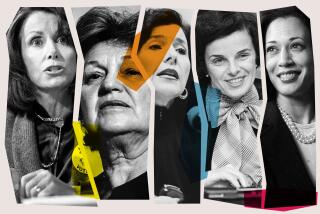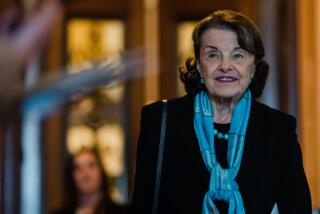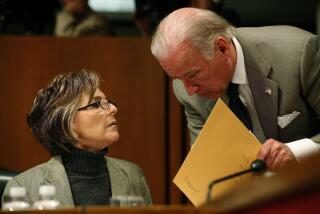Boxer, Feinstein Rivalry Is Softened by Historic Election
SAN FRANCISCO — It was early in the morning after Election Day and Democrats Barbara Boxer and Dianne Feinstein were seated side by side beneath a towering set of klieg lights in the Fairmont Hotel.
The two U.S. senators-elect, making the round of television news shows just hours after claiming their historic victories, were instructed by a sound technician to count to five for a voice check on their microphones.
“One, two, three, four, five,” Boxer responded in rapid fire.
“Five, four, three, two, one,” Feinstein countered slowly and deliberately.
“Team work!” Boxer quickly interjected, repeating a common refrain--and hopeful promise--of their dual campaigns.
Perhaps. But like much about California’s two new senators, their differing approaches to the simple task of counting to five says as much about what divides the veteran--and sometimes rival--politicians as what unites them.
Despite a widespread perception cultivated by the state Democratic Party that the Senate winners from Northern California are a like-minded pair of sisters, Boxer and Feinstein come from very different political traditions and, until recently, often competing sides of the Democratic fence.
It was only two years ago that Boxer endorsed Feinstein’s opponent in the Democratic gubernatorial primary, going so far as to call him the “best feminist in the race” and appearing with him the night of his defeat. And a decade ago, Feinstein--then mayor of San Francisco--worked earnestly for Boxer’s primary foe in the Marin County supervisor’s first successful bid for Congress, even appearing in her opponent’s television ads.
As early as 1979, Boxer offended Feinstein by contributing $99--one dollar less than the minimum amount that must be reported by campaigns--to Feinstein’s top challenger in the San Francisco mayoral race.
This week, the two women victors celebrated their success at the same hotel only at the insistence of state Democratic Party Chairman Phil Angelides, who was determined to present a picture of a united Democratic front. Even so, Boxer and Feinstein held out for separate parties within the hotel, and only appeared together briefly toward the end of the evening. Both women also skipped a scheduled joint appearance the next morning.
“Guys, don’t read anything into that,” Angelides told reporters. “These two are going to be an absolute team.”
Coming from opposite sides of the Golden Gate Bridge and different wings of the Democratic Party, Boxer, 51, and Feinstein, 59, make an unlikely duo.
A pragmatist and centrist with political roots at City Hall, Feinstein has built a career as a policy wonk who measures success in concrete, if sometimes unsensational, results. Detractors within her party have accused her of being a closet Republican, pointing to her longtime support for the death penalty, strong pro-business stance and years of downplaying the feminist agenda.
An avowed liberal ideologue representing a largely affluent suburban county, Boxer places a premium on rattling cages and speaking out for causes--sometimes radical ones--even when words are all she can deliver. Critics complain that she is an ineffective legislator whose old-style liberalism puts her at the fringe of the Democratic Party and clearly out of sync with Feinstein’s hands-on conciliatory style.
The tone of their acceptance speeches Tuesday night reflected the essence of their differing political selves. An exuberant but composed Feinstein ticked off a laundry list of specific tasks ahead, while a fiery and emotional Boxer flashed her trademark boxing glove and pledged to fight for everything from a cure for cancer to women’s rights.
“Election night was a good reminder . . . they are really quite different,” said Don Solem, a veteran San Francisco public affairs consultant. “I would say, why shouldn’t they be? It is almost a male point of view that all women politicians should be alike. That is not only unfair, it is plain wrong.”
In recent campaign appearances and in separate post-election interviews, Boxer and Feinstein asserted that they have put their differences behind them. They say they have grown to become good friends and have pledged to work together on a common California agenda. Their claim to be the “Cagney & Lacey” of senatorial politics has drawn nationwide attention, and friends say they have witnessed genuine exchanges of warmth between the two new colleagues.
“They have bonded in a remarkable way,” said San Francisco attorney Duane Garrett, who was chairman of Feinstein’s Senate campaign this year and Boxer’s congressional campaign in 1982. “My sense is that their two styles will be very complementary and that this is a classic example of one plus one makes more than two.”
Although no one expects a melding of their distinctive styles, political expediency--if nothing else--should dictate a close working relationship on Capitol Hill. Feinstein faces reelection in just two years and will need Boxer’s cooperation in swiftly compiling a record of legislative accomplishment. Boxer is widely perceived as being indebted to Feinstein, who at some political risk to herself abandoned the final days of her campaign schedule to make a blitz of joint appearances with Boxer as Boxer’s Republican foe, Bruce Herschensohn, surged in the polls.
“They come from two places in the Democratic Party and it is somewhat natural that at various points they would have clashed,” said political consultant Clinton Reilly, who has run campaigns for both women. “But now their self-interests are identical, and they are no longer competitive with one another. I would expect them to maintain an effective and strong working relationship.”
The two women differ on some issues, such as giving the President a line-item veto (Feinstein favors it, Boxer opposes it), but their campaigns focused primarily on common bread-and-butter themes affecting California. With expectations high among voters, there will be pressure for the two women to work in tandem and “bring home the bacon,” as one Feinstein campaign official said.
What political necessity does not dictate, historical legacy may. As the first all-female delegation to the U.S. Senate, the two women are tuned to the historic overtones of their dual presence in Washington. Neither wants their partnership to become a model of historic ridicule, aides said.
“The day after the primary, when we traveled around the state . . . I remember one point when Dianne was sitting next to Barbara,” Angelides said. “She held her hand, and said: ‘Barbara, what we’re doing here is very historic and people are counting on us.’ In that moment, whatever had existed prior to that, be it rivalry or being from different political camps, was wiped away.”
Garrett said he talked to Feinstein and Boxer after they returned from the daylong state tour and was struck by their instantaneous kinship.
The groundwork for their rapprochement was laid during the 1990 gubernatorial general election after Feinstein’s so-called public conversion to the feminist cause, several mutual acquaintances said. Boxer had long resented Feinstein’s unwillingness to aggressively promote women’s issues, but during the general election--when Boxer campaigned for Feinstein against then-Sen. Pete Wilson--the Greenbrae congresswoman was taken by Feinstein’s performance at women’s rallies.
“Their relationship was quickly patched following that campaign,” said Hadley Roff, who served as Feinstein’s chief of staff during the gubernatorial race. “I think people are trying to find more of a difference now than there really is.”
Yet the day after their victories, San Francisco was abuzz with talk of the two women’s first decisions as senators-elect: Boxer boarded an airplane for a vacation in Hawaii while Feinstein summoned her top advisers to her home for a brain-storming session about her transition to the Senate.
Again, Angelides cautioned reporters not to read anything into the differing decisions. Both women, he said, will be in Washington on Monday for a two-day orientation for first-term senators.
More to Read
Get the L.A. Times Politics newsletter
Deeply reported insights into legislation, politics and policy from Sacramento, Washington and beyond. In your inbox three times per week.
You may occasionally receive promotional content from the Los Angeles Times.










